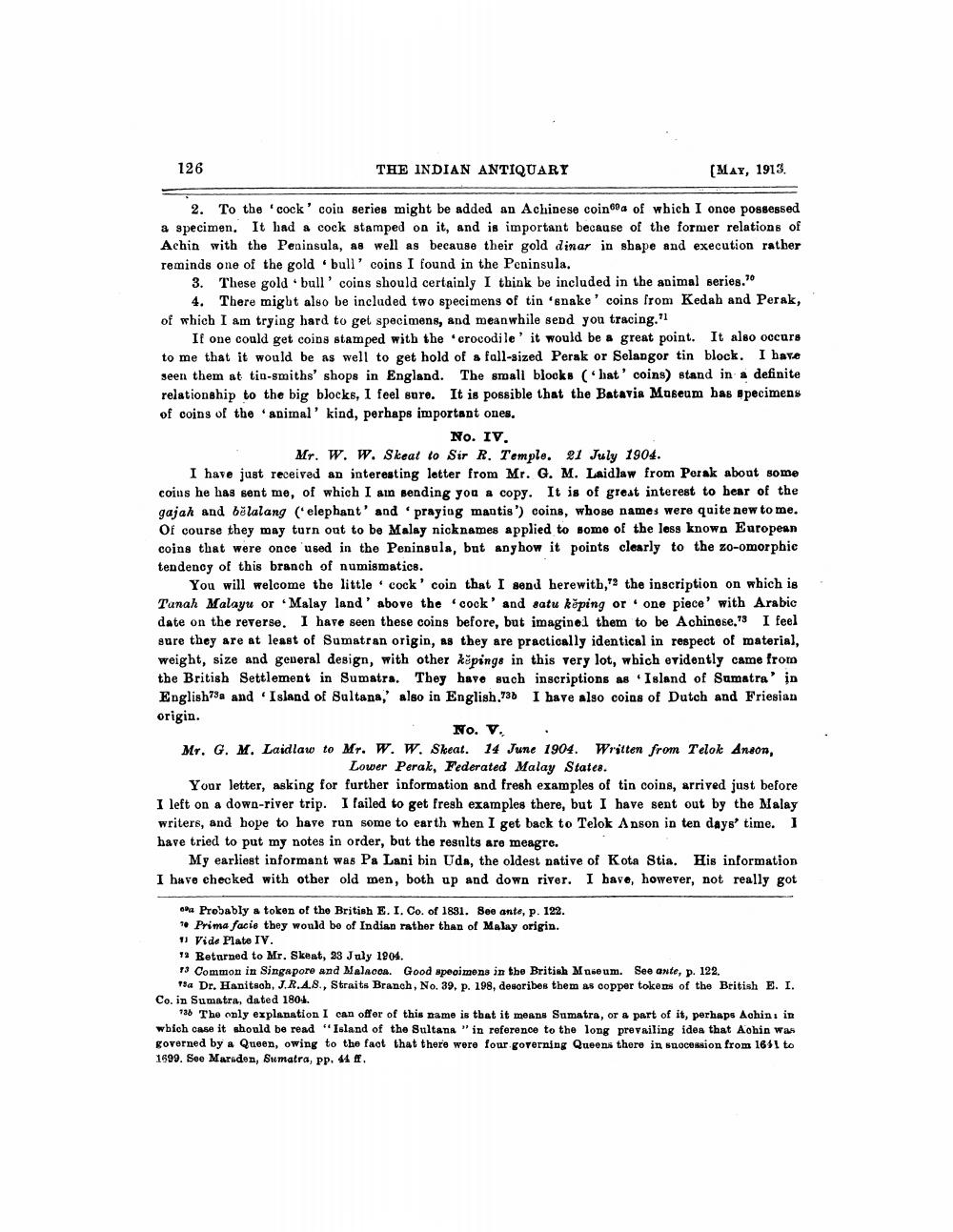________________
126
THE INDIAN ANTIQUARI
(May, 1913
2. To the cock' coin series might be added an Achinese coina of which I once possessed a specimen. It had a cock stamped on it, and is important because of the former relations of Achin with the Peninsula, as well as because their gold dinar in shape and execution rather reminds one of the gold bull' coins I found in the Peninsula.
3. These gold bull' coins should certainly I think be included in the animal series."
4. There might also be included two specimens of tin 'snake' coins from Kedah and Perak, of which I am trying hard to get specimens, and meanwhile send you tracing."
If one could get coins stamped with the crocodile' it would be a great point. It also occurs to me that it would be as well to get hold of a fall-sized Perak or Selangor tin block. I have seen them at tio-smiths' shops in England. The small blocks (bat' coins) stand in a definite relationship to the big blocks, I feel sure. It is possible that the Batavia Museum has specimens of coins of the animal' kind, perhaps important ones.
No. IV. Mr. W. W. Skeat to Sir R. Temple. 21 July 1904. I have just received an interesting letter from Mr. G. M. Laidlaw from Perak about some coins he has sent me, of which I ain sending you a copy. It is of great interest to bear of the gajah and belalang ( elephant' and praying mantis') coins, whose names were quite new to me. Of course they may turn out to be Malay nicknames applied to some of the loss known European coins that were once 'used in the Peninsula, but any how it points clearly to the zo-omorphic tendency of this branch of numismatics.
You will welcome the little cock' coin that I send herewith," the inscription on which is Tanah Malayu or Malay land above the cock' and satu keping or one piece' with Arabic date on the reverse. I have seen these coins before, but imagine them to be Achinese. I feel sure they are at least of Sumatran origin, as they are practically identical in respect of material, weight, size and general design, with other kepings in this very lot, which evidently came from the British Settlement in Sumatra. They have such inscriptions as Island of Sumatra' in English73a and Island of Sultana,' also in English.738 I have also coins of Dutch and Friesian origin.
No. v. Mr. G. M. Laidlaw to Mr. W. W. Skeat. 14 June 1904. Written from Telok Anson,
Lower Perak, Federated Malay States. Your letter, asking for further information and fresh examples of tin coins, arrived just before I left on a down-river trip. I failed to get fresh examples there, but I have sent out by the Malay writers, and hope to have run some to earth when I get back to Telok Anson in ten days' time. I have tried to put my notes in order, but the results are meagre.
My earliest informant was Pa Lani bin Uda, the oldest native of Kota Stia. His information I have checked with other old men, both up and down river. I have, however, not really got
oh Probably a token of the British E. I. Co. of 1891. Bee ante, p. 122. • Prima facie they would be of Indian rather than of Malay origin. 11 Vide Plate IV. 12 Returned to Mr. Skeat, 23 July 1904. 13 Common in Singapore and Malacoa. Good specimens in the British Museum. See ante, p. 122.
18a Dr. Hanitsch, J.R.A.S., Straits Branch, No. 39. p. 198, desoribes them as copper tokens of the British E. I. Co. in Sumatra, dated 1804.
786 The only explanation I can offor of this name is that it means Sumatra, or a part of it, perhaps Aohin: in wbich case it should be read "Ioland of the Sultana "in reference to the long prevailing idea that Aohin was governed by a Queen, owing to the fact that there were four governing Queens there in succession from 1651 to 1699. Soe Marsden, Sumatra, pp. 44 f.




